Critical Evaluation of AOD and Mental Health Relationship
VerifiedAdded on 2022/08/19
|11
|3670
|31
Essay
AI Summary
This essay critically examines the intricate relationship between Alcohol and Other Drug (AOD) use and mental health, focusing on the adverse effects of various substances on mental well-being, including depression, anxiety, and psychotic reactions. The essay highlights the challenges in treating dual disorders and discusses the role of environmental factors in exacerbating AOD and mental health issues. It then analyzes the NEAMI organization, an agency employing the Collaborative Recovery Model (CRM), a person-centered, evidence-based approach to provide psychosocial rehabilitation services for individuals with mental health illnesses and disabilities. The CRM model emphasizes self-direction, empowerment, and strength-based approaches to aid recovery, with a focus on improving the mental and physical well-being of individuals within their communities. The essay concludes by emphasizing the importance of community support and evidence-based treatments in addressing the global impact of AOD and mental disorders.
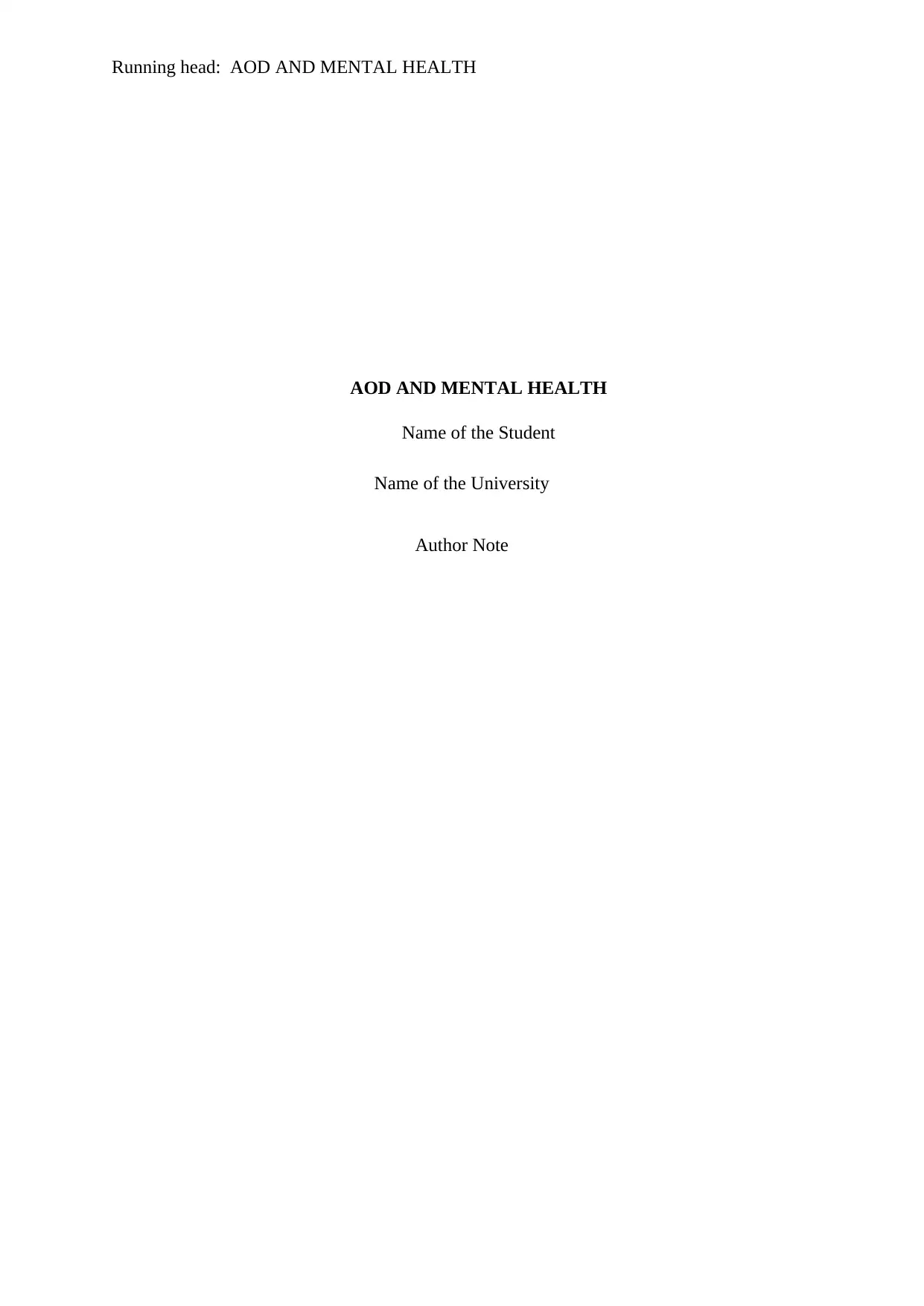
Running head: AOD AND MENTAL HEALTH
AOD AND MENTAL HEALTH
Name of the Student
Name of the University
Author Note
AOD AND MENTAL HEALTH
Name of the Student
Name of the University
Author Note
Paraphrase This Document
Need a fresh take? Get an instant paraphrase of this document with our AI Paraphraser
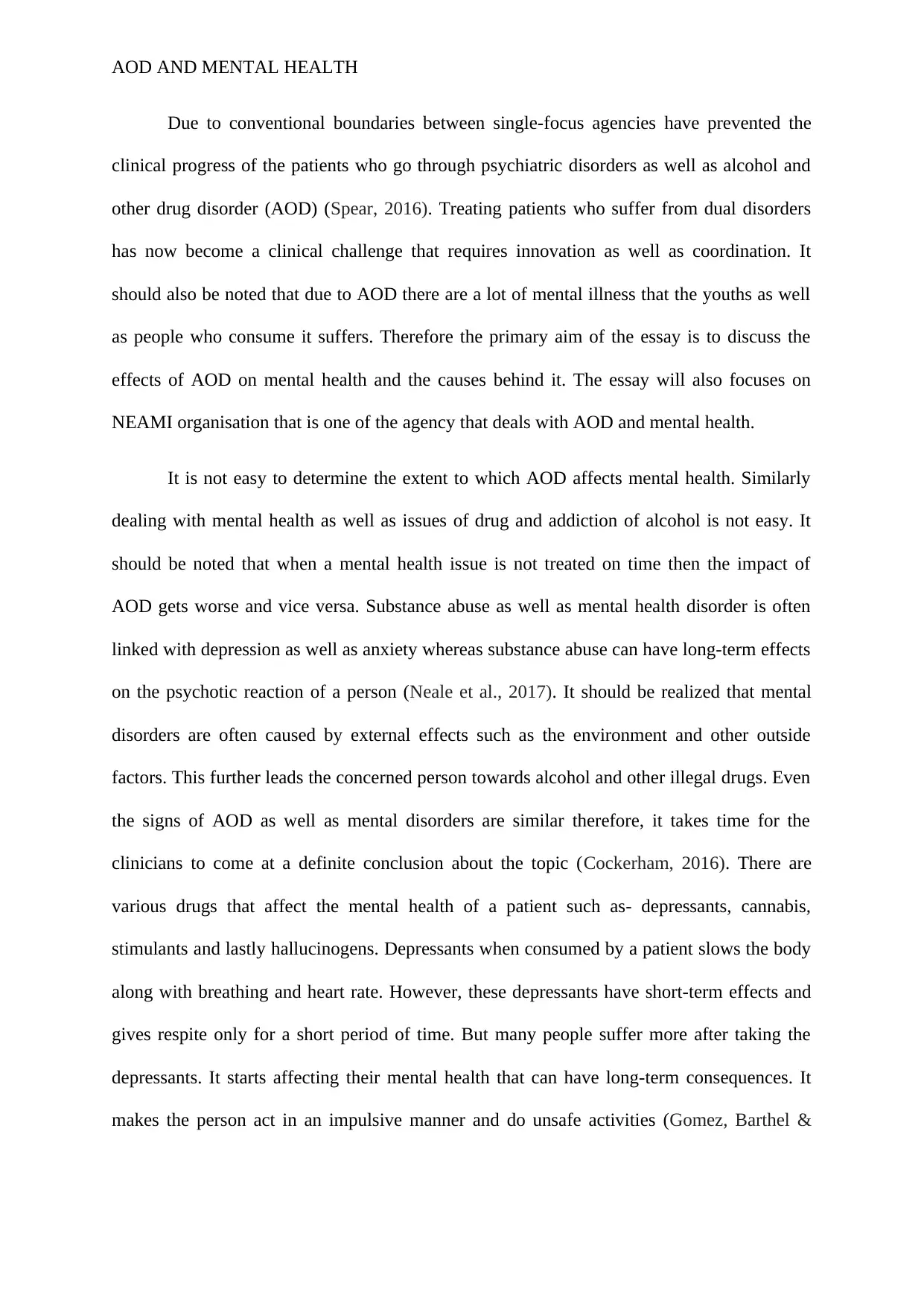
AOD AND MENTAL HEALTH
Due to conventional boundaries between single-focus agencies have prevented the
clinical progress of the patients who go through psychiatric disorders as well as alcohol and
other drug disorder (AOD) (Spear, 2016). Treating patients who suffer from dual disorders
has now become a clinical challenge that requires innovation as well as coordination. It
should also be noted that due to AOD there are a lot of mental illness that the youths as well
as people who consume it suffers. Therefore the primary aim of the essay is to discuss the
effects of AOD on mental health and the causes behind it. The essay will also focuses on
NEAMI organisation that is one of the agency that deals with AOD and mental health.
It is not easy to determine the extent to which AOD affects mental health. Similarly
dealing with mental health as well as issues of drug and addiction of alcohol is not easy. It
should be noted that when a mental health issue is not treated on time then the impact of
AOD gets worse and vice versa. Substance abuse as well as mental health disorder is often
linked with depression as well as anxiety whereas substance abuse can have long-term effects
on the psychotic reaction of a person (Neale et al., 2017). It should be realized that mental
disorders are often caused by external effects such as the environment and other outside
factors. This further leads the concerned person towards alcohol and other illegal drugs. Even
the signs of AOD as well as mental disorders are similar therefore, it takes time for the
clinicians to come at a definite conclusion about the topic (Cockerham, 2016). There are
various drugs that affect the mental health of a patient such as- depressants, cannabis,
stimulants and lastly hallucinogens. Depressants when consumed by a patient slows the body
along with breathing and heart rate. However, these depressants have short-term effects and
gives respite only for a short period of time. But many people suffer more after taking the
depressants. It starts affecting their mental health that can have long-term consequences. It
makes the person act in an impulsive manner and do unsafe activities (Gomez, Barthel &
Due to conventional boundaries between single-focus agencies have prevented the
clinical progress of the patients who go through psychiatric disorders as well as alcohol and
other drug disorder (AOD) (Spear, 2016). Treating patients who suffer from dual disorders
has now become a clinical challenge that requires innovation as well as coordination. It
should also be noted that due to AOD there are a lot of mental illness that the youths as well
as people who consume it suffers. Therefore the primary aim of the essay is to discuss the
effects of AOD on mental health and the causes behind it. The essay will also focuses on
NEAMI organisation that is one of the agency that deals with AOD and mental health.
It is not easy to determine the extent to which AOD affects mental health. Similarly
dealing with mental health as well as issues of drug and addiction of alcohol is not easy. It
should be noted that when a mental health issue is not treated on time then the impact of
AOD gets worse and vice versa. Substance abuse as well as mental health disorder is often
linked with depression as well as anxiety whereas substance abuse can have long-term effects
on the psychotic reaction of a person (Neale et al., 2017). It should be realized that mental
disorders are often caused by external effects such as the environment and other outside
factors. This further leads the concerned person towards alcohol and other illegal drugs. Even
the signs of AOD as well as mental disorders are similar therefore, it takes time for the
clinicians to come at a definite conclusion about the topic (Cockerham, 2016). There are
various drugs that affect the mental health of a patient such as- depressants, cannabis,
stimulants and lastly hallucinogens. Depressants when consumed by a patient slows the body
along with breathing and heart rate. However, these depressants have short-term effects and
gives respite only for a short period of time. But many people suffer more after taking the
depressants. It starts affecting their mental health that can have long-term consequences. It
makes the person act in an impulsive manner and do unsafe activities (Gomez, Barthel &
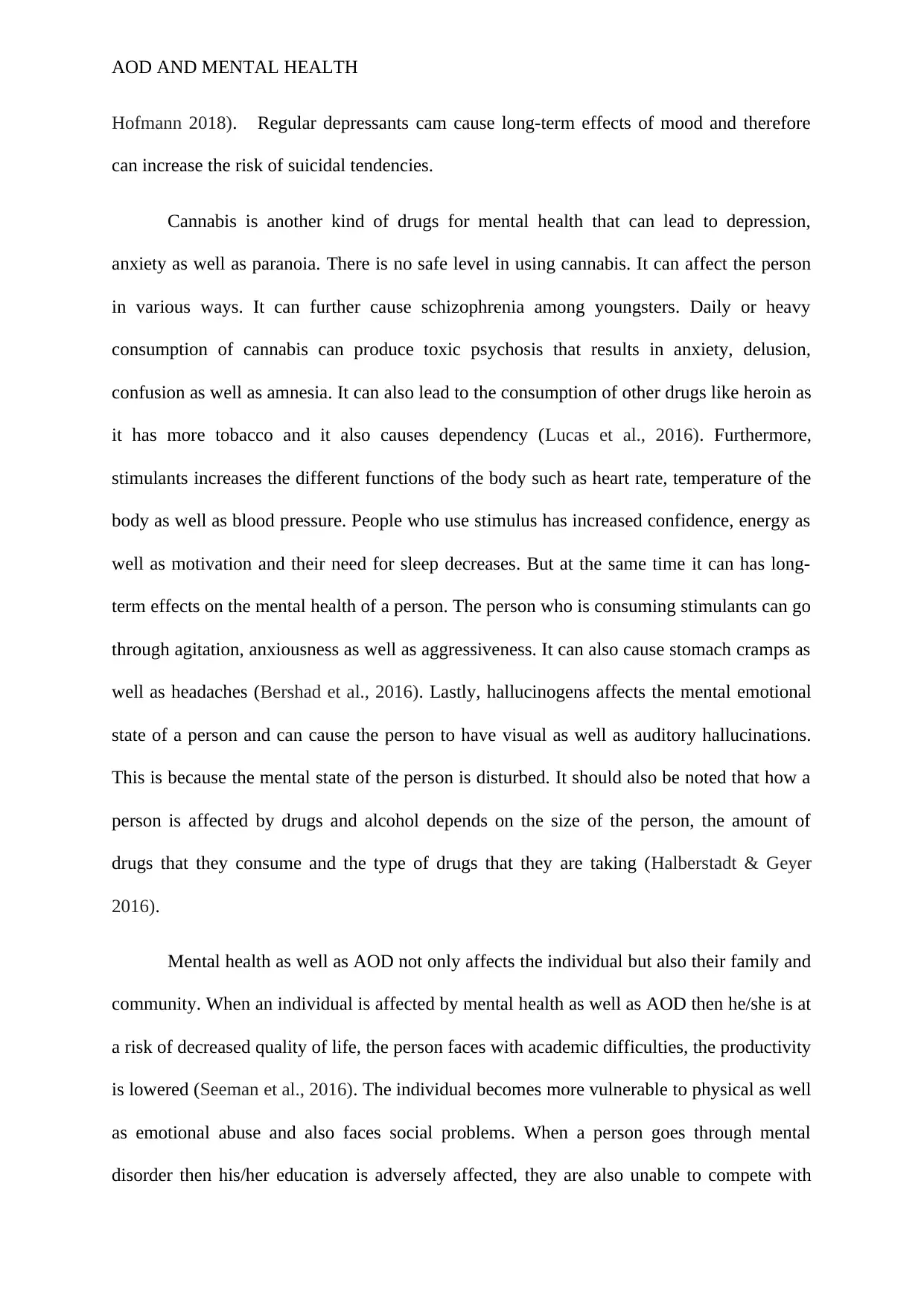
AOD AND MENTAL HEALTH
Hofmann 2018). Regular depressants cam cause long-term effects of mood and therefore
can increase the risk of suicidal tendencies.
Cannabis is another kind of drugs for mental health that can lead to depression,
anxiety as well as paranoia. There is no safe level in using cannabis. It can affect the person
in various ways. It can further cause schizophrenia among youngsters. Daily or heavy
consumption of cannabis can produce toxic psychosis that results in anxiety, delusion,
confusion as well as amnesia. It can also lead to the consumption of other drugs like heroin as
it has more tobacco and it also causes dependency (Lucas et al., 2016). Furthermore,
stimulants increases the different functions of the body such as heart rate, temperature of the
body as well as blood pressure. People who use stimulus has increased confidence, energy as
well as motivation and their need for sleep decreases. But at the same time it can has long-
term effects on the mental health of a person. The person who is consuming stimulants can go
through agitation, anxiousness as well as aggressiveness. It can also cause stomach cramps as
well as headaches (Bershad et al., 2016). Lastly, hallucinogens affects the mental emotional
state of a person and can cause the person to have visual as well as auditory hallucinations.
This is because the mental state of the person is disturbed. It should also be noted that how a
person is affected by drugs and alcohol depends on the size of the person, the amount of
drugs that they consume and the type of drugs that they are taking (Halberstadt & Geyer
2016).
Mental health as well as AOD not only affects the individual but also their family and
community. When an individual is affected by mental health as well as AOD then he/she is at
a risk of decreased quality of life, the person faces with academic difficulties, the productivity
is lowered (Seeman et al., 2016). The individual becomes more vulnerable to physical as well
as emotional abuse and also faces social problems. When a person goes through mental
disorder then his/her education is adversely affected, they are also unable to compete with
Hofmann 2018). Regular depressants cam cause long-term effects of mood and therefore
can increase the risk of suicidal tendencies.
Cannabis is another kind of drugs for mental health that can lead to depression,
anxiety as well as paranoia. There is no safe level in using cannabis. It can affect the person
in various ways. It can further cause schizophrenia among youngsters. Daily or heavy
consumption of cannabis can produce toxic psychosis that results in anxiety, delusion,
confusion as well as amnesia. It can also lead to the consumption of other drugs like heroin as
it has more tobacco and it also causes dependency (Lucas et al., 2016). Furthermore,
stimulants increases the different functions of the body such as heart rate, temperature of the
body as well as blood pressure. People who use stimulus has increased confidence, energy as
well as motivation and their need for sleep decreases. But at the same time it can has long-
term effects on the mental health of a person. The person who is consuming stimulants can go
through agitation, anxiousness as well as aggressiveness. It can also cause stomach cramps as
well as headaches (Bershad et al., 2016). Lastly, hallucinogens affects the mental emotional
state of a person and can cause the person to have visual as well as auditory hallucinations.
This is because the mental state of the person is disturbed. It should also be noted that how a
person is affected by drugs and alcohol depends on the size of the person, the amount of
drugs that they consume and the type of drugs that they are taking (Halberstadt & Geyer
2016).
Mental health as well as AOD not only affects the individual but also their family and
community. When an individual is affected by mental health as well as AOD then he/she is at
a risk of decreased quality of life, the person faces with academic difficulties, the productivity
is lowered (Seeman et al., 2016). The individual becomes more vulnerable to physical as well
as emotional abuse and also faces social problems. When a person goes through mental
disorder then his/her education is adversely affected, they are also unable to compete with
⊘ This is a preview!⊘
Do you want full access?
Subscribe today to unlock all pages.

Trusted by 1+ million students worldwide
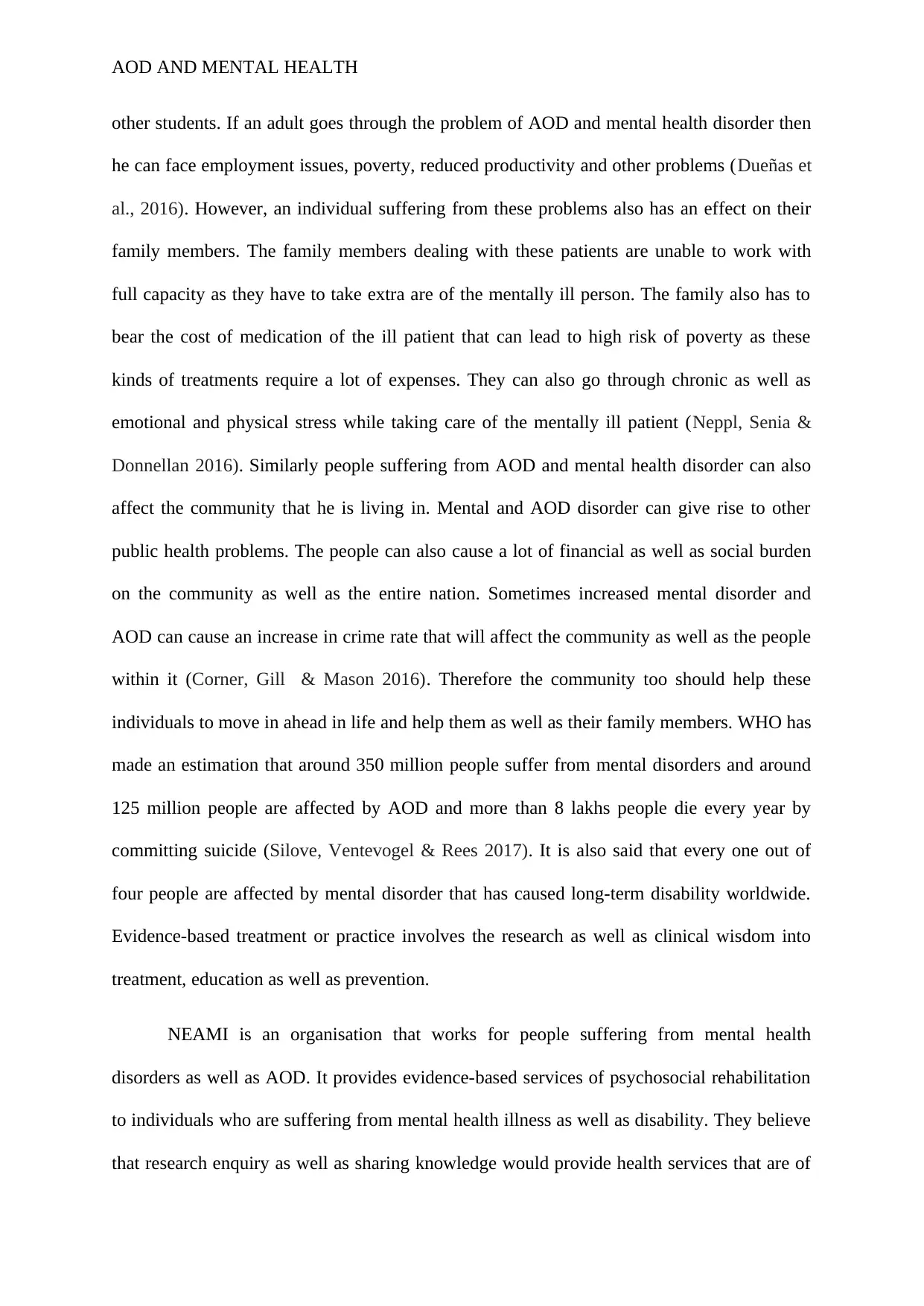
AOD AND MENTAL HEALTH
other students. If an adult goes through the problem of AOD and mental health disorder then
he can face employment issues, poverty, reduced productivity and other problems (Dueñas et
al., 2016). However, an individual suffering from these problems also has an effect on their
family members. The family members dealing with these patients are unable to work with
full capacity as they have to take extra are of the mentally ill person. The family also has to
bear the cost of medication of the ill patient that can lead to high risk of poverty as these
kinds of treatments require a lot of expenses. They can also go through chronic as well as
emotional and physical stress while taking care of the mentally ill patient (Neppl, Senia &
Donnellan 2016). Similarly people suffering from AOD and mental health disorder can also
affect the community that he is living in. Mental and AOD disorder can give rise to other
public health problems. The people can also cause a lot of financial as well as social burden
on the community as well as the entire nation. Sometimes increased mental disorder and
AOD can cause an increase in crime rate that will affect the community as well as the people
within it (Corner, Gill & Mason 2016). Therefore the community too should help these
individuals to move in ahead in life and help them as well as their family members. WHO has
made an estimation that around 350 million people suffer from mental disorders and around
125 million people are affected by AOD and more than 8 lakhs people die every year by
committing suicide (Silove, Ventevogel & Rees 2017). It is also said that every one out of
four people are affected by mental disorder that has caused long-term disability worldwide.
Evidence-based treatment or practice involves the research as well as clinical wisdom into
treatment, education as well as prevention.
NEAMI is an organisation that works for people suffering from mental health
disorders as well as AOD. It provides evidence-based services of psychosocial rehabilitation
to individuals who are suffering from mental health illness as well as disability. They believe
that research enquiry as well as sharing knowledge would provide health services that are of
other students. If an adult goes through the problem of AOD and mental health disorder then
he can face employment issues, poverty, reduced productivity and other problems (Dueñas et
al., 2016). However, an individual suffering from these problems also has an effect on their
family members. The family members dealing with these patients are unable to work with
full capacity as they have to take extra are of the mentally ill person. The family also has to
bear the cost of medication of the ill patient that can lead to high risk of poverty as these
kinds of treatments require a lot of expenses. They can also go through chronic as well as
emotional and physical stress while taking care of the mentally ill patient (Neppl, Senia &
Donnellan 2016). Similarly people suffering from AOD and mental health disorder can also
affect the community that he is living in. Mental and AOD disorder can give rise to other
public health problems. The people can also cause a lot of financial as well as social burden
on the community as well as the entire nation. Sometimes increased mental disorder and
AOD can cause an increase in crime rate that will affect the community as well as the people
within it (Corner, Gill & Mason 2016). Therefore the community too should help these
individuals to move in ahead in life and help them as well as their family members. WHO has
made an estimation that around 350 million people suffer from mental disorders and around
125 million people are affected by AOD and more than 8 lakhs people die every year by
committing suicide (Silove, Ventevogel & Rees 2017). It is also said that every one out of
four people are affected by mental disorder that has caused long-term disability worldwide.
Evidence-based treatment or practice involves the research as well as clinical wisdom into
treatment, education as well as prevention.
NEAMI is an organisation that works for people suffering from mental health
disorders as well as AOD. It provides evidence-based services of psychosocial rehabilitation
to individuals who are suffering from mental health illness as well as disability. They believe
that research enquiry as well as sharing knowledge would provide health services that are of
Paraphrase This Document
Need a fresh take? Get an instant paraphrase of this document with our AI Paraphraser
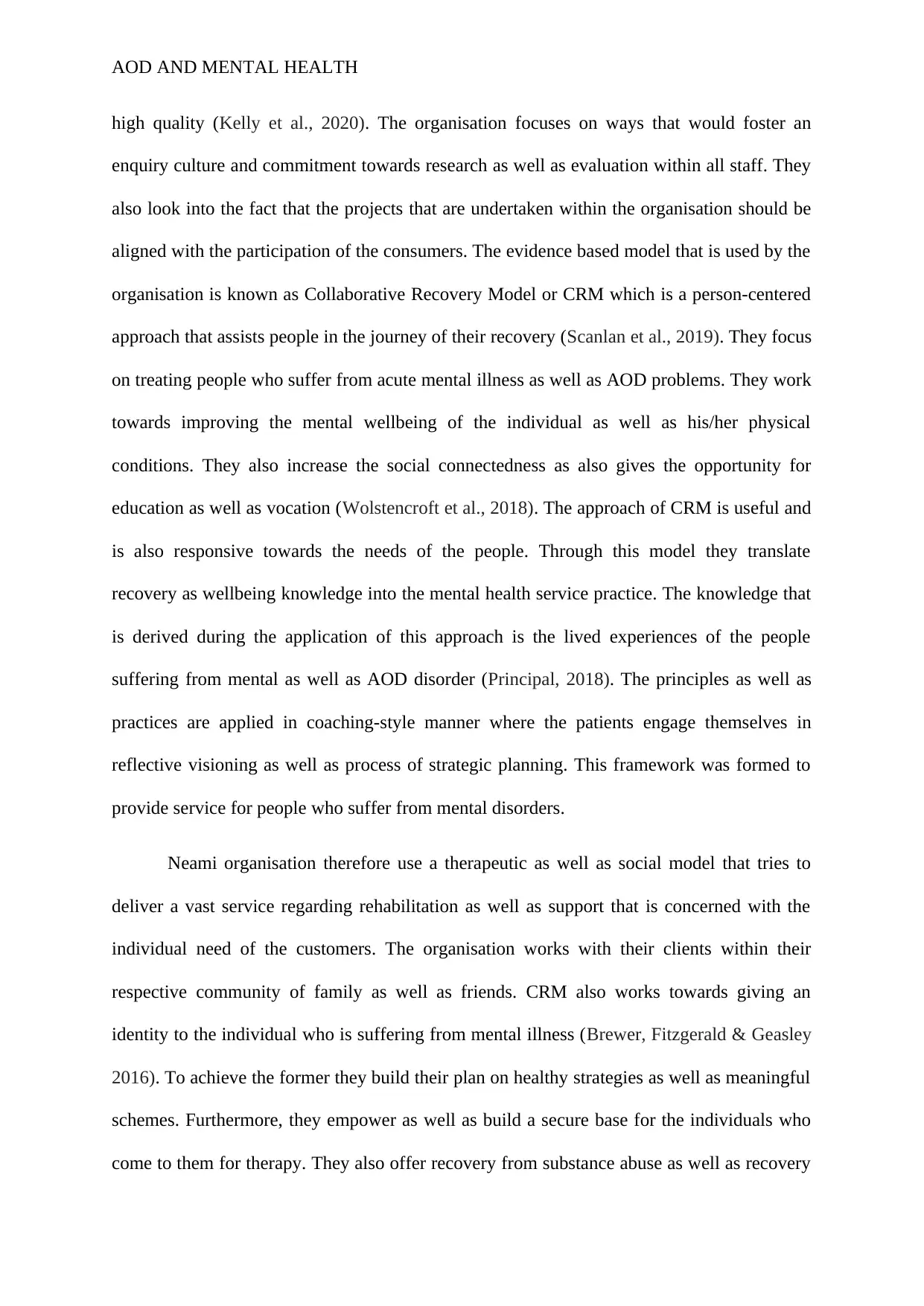
AOD AND MENTAL HEALTH
high quality (Kelly et al., 2020). The organisation focuses on ways that would foster an
enquiry culture and commitment towards research as well as evaluation within all staff. They
also look into the fact that the projects that are undertaken within the organisation should be
aligned with the participation of the consumers. The evidence based model that is used by the
organisation is known as Collaborative Recovery Model or CRM which is a person-centered
approach that assists people in the journey of their recovery (Scanlan et al., 2019). They focus
on treating people who suffer from acute mental illness as well as AOD problems. They work
towards improving the mental wellbeing of the individual as well as his/her physical
conditions. They also increase the social connectedness as also gives the opportunity for
education as well as vocation (Wolstencroft et al., 2018). The approach of CRM is useful and
is also responsive towards the needs of the people. Through this model they translate
recovery as wellbeing knowledge into the mental health service practice. The knowledge that
is derived during the application of this approach is the lived experiences of the people
suffering from mental as well as AOD disorder (Principal, 2018). The principles as well as
practices are applied in coaching-style manner where the patients engage themselves in
reflective visioning as well as process of strategic planning. This framework was formed to
provide service for people who suffer from mental disorders.
Neami organisation therefore use a therapeutic as well as social model that tries to
deliver a vast service regarding rehabilitation as well as support that is concerned with the
individual need of the customers. The organisation works with their clients within their
respective community of family as well as friends. CRM also works towards giving an
identity to the individual who is suffering from mental illness (Brewer, Fitzgerald & Geasley
2016). To achieve the former they build their plan on healthy strategies as well as meaningful
schemes. Furthermore, they empower as well as build a secure base for the individuals who
come to them for therapy. They also offer recovery from substance abuse as well as recovery
high quality (Kelly et al., 2020). The organisation focuses on ways that would foster an
enquiry culture and commitment towards research as well as evaluation within all staff. They
also look into the fact that the projects that are undertaken within the organisation should be
aligned with the participation of the consumers. The evidence based model that is used by the
organisation is known as Collaborative Recovery Model or CRM which is a person-centered
approach that assists people in the journey of their recovery (Scanlan et al., 2019). They focus
on treating people who suffer from acute mental illness as well as AOD problems. They work
towards improving the mental wellbeing of the individual as well as his/her physical
conditions. They also increase the social connectedness as also gives the opportunity for
education as well as vocation (Wolstencroft et al., 2018). The approach of CRM is useful and
is also responsive towards the needs of the people. Through this model they translate
recovery as wellbeing knowledge into the mental health service practice. The knowledge that
is derived during the application of this approach is the lived experiences of the people
suffering from mental as well as AOD disorder (Principal, 2018). The principles as well as
practices are applied in coaching-style manner where the patients engage themselves in
reflective visioning as well as process of strategic planning. This framework was formed to
provide service for people who suffer from mental disorders.
Neami organisation therefore use a therapeutic as well as social model that tries to
deliver a vast service regarding rehabilitation as well as support that is concerned with the
individual need of the customers. The organisation works with their clients within their
respective community of family as well as friends. CRM also works towards giving an
identity to the individual who is suffering from mental illness (Brewer, Fitzgerald & Geasley
2016). To achieve the former they build their plan on healthy strategies as well as meaningful
schemes. Furthermore, they empower as well as build a secure base for the individuals who
come to them for therapy. They also offer recovery from substance abuse as well as recovery
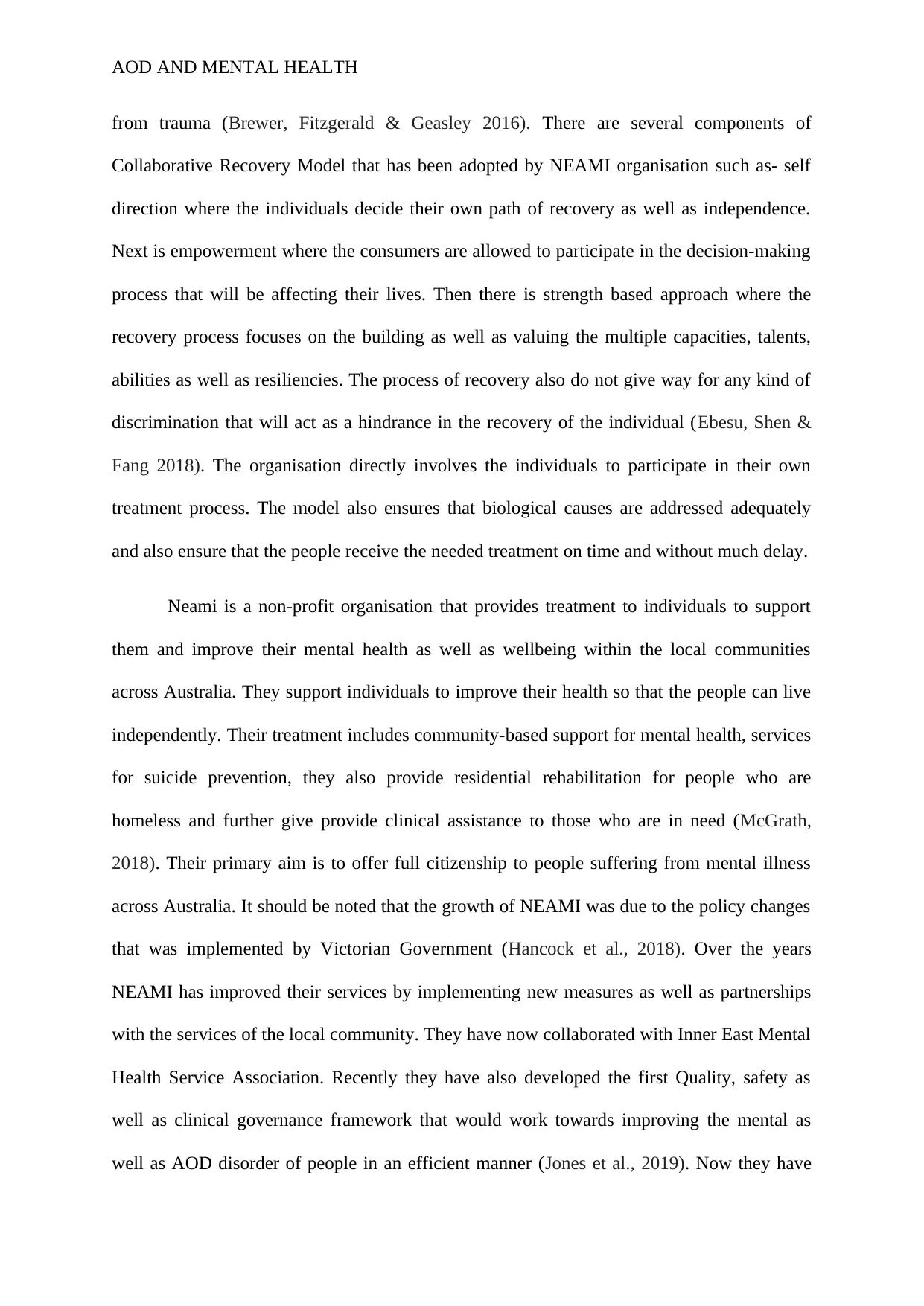
AOD AND MENTAL HEALTH
from trauma (Brewer, Fitzgerald & Geasley 2016). There are several components of
Collaborative Recovery Model that has been adopted by NEAMI organisation such as- self
direction where the individuals decide their own path of recovery as well as independence.
Next is empowerment where the consumers are allowed to participate in the decision-making
process that will be affecting their lives. Then there is strength based approach where the
recovery process focuses on the building as well as valuing the multiple capacities, talents,
abilities as well as resiliencies. The process of recovery also do not give way for any kind of
discrimination that will act as a hindrance in the recovery of the individual (Ebesu, Shen &
Fang 2018). The organisation directly involves the individuals to participate in their own
treatment process. The model also ensures that biological causes are addressed adequately
and also ensure that the people receive the needed treatment on time and without much delay.
Neami is a non-profit organisation that provides treatment to individuals to support
them and improve their mental health as well as wellbeing within the local communities
across Australia. They support individuals to improve their health so that the people can live
independently. Their treatment includes community-based support for mental health, services
for suicide prevention, they also provide residential rehabilitation for people who are
homeless and further give provide clinical assistance to those who are in need (McGrath,
2018). Their primary aim is to offer full citizenship to people suffering from mental illness
across Australia. It should be noted that the growth of NEAMI was due to the policy changes
that was implemented by Victorian Government (Hancock et al., 2018). Over the years
NEAMI has improved their services by implementing new measures as well as partnerships
with the services of the local community. They have now collaborated with Inner East Mental
Health Service Association. Recently they have also developed the first Quality, safety as
well as clinical governance framework that would work towards improving the mental as
well as AOD disorder of people in an efficient manner (Jones et al., 2019). Now they have
from trauma (Brewer, Fitzgerald & Geasley 2016). There are several components of
Collaborative Recovery Model that has been adopted by NEAMI organisation such as- self
direction where the individuals decide their own path of recovery as well as independence.
Next is empowerment where the consumers are allowed to participate in the decision-making
process that will be affecting their lives. Then there is strength based approach where the
recovery process focuses on the building as well as valuing the multiple capacities, talents,
abilities as well as resiliencies. The process of recovery also do not give way for any kind of
discrimination that will act as a hindrance in the recovery of the individual (Ebesu, Shen &
Fang 2018). The organisation directly involves the individuals to participate in their own
treatment process. The model also ensures that biological causes are addressed adequately
and also ensure that the people receive the needed treatment on time and without much delay.
Neami is a non-profit organisation that provides treatment to individuals to support
them and improve their mental health as well as wellbeing within the local communities
across Australia. They support individuals to improve their health so that the people can live
independently. Their treatment includes community-based support for mental health, services
for suicide prevention, they also provide residential rehabilitation for people who are
homeless and further give provide clinical assistance to those who are in need (McGrath,
2018). Their primary aim is to offer full citizenship to people suffering from mental illness
across Australia. It should be noted that the growth of NEAMI was due to the policy changes
that was implemented by Victorian Government (Hancock et al., 2018). Over the years
NEAMI has improved their services by implementing new measures as well as partnerships
with the services of the local community. They have now collaborated with Inner East Mental
Health Service Association. Recently they have also developed the first Quality, safety as
well as clinical governance framework that would work towards improving the mental as
well as AOD disorder of people in an efficient manner (Jones et al., 2019). Now they have
⊘ This is a preview!⊘
Do you want full access?
Subscribe today to unlock all pages.

Trusted by 1+ million students worldwide
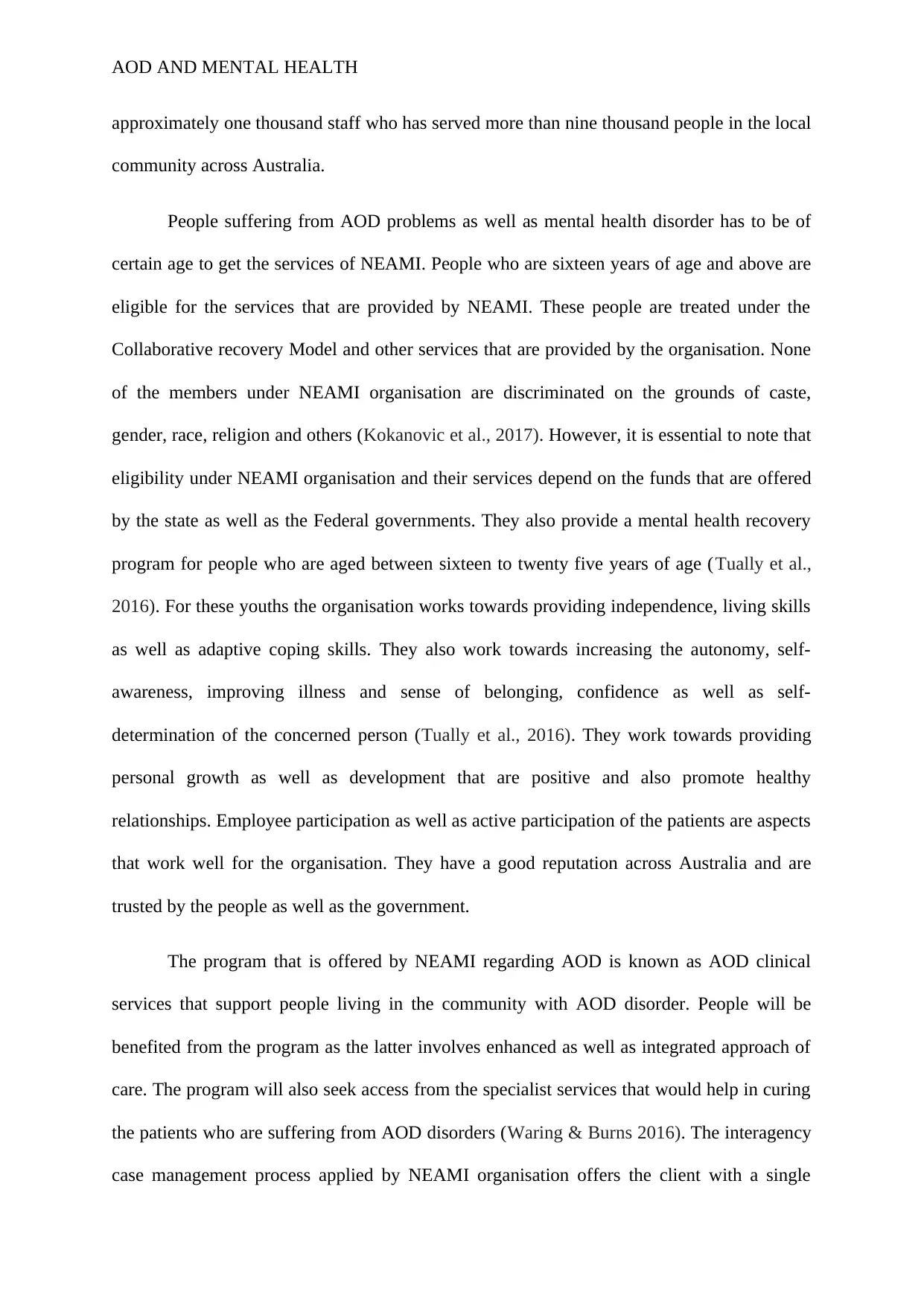
AOD AND MENTAL HEALTH
approximately one thousand staff who has served more than nine thousand people in the local
community across Australia.
People suffering from AOD problems as well as mental health disorder has to be of
certain age to get the services of NEAMI. People who are sixteen years of age and above are
eligible for the services that are provided by NEAMI. These people are treated under the
Collaborative recovery Model and other services that are provided by the organisation. None
of the members under NEAMI organisation are discriminated on the grounds of caste,
gender, race, religion and others (Kokanovic et al., 2017). However, it is essential to note that
eligibility under NEAMI organisation and their services depend on the funds that are offered
by the state as well as the Federal governments. They also provide a mental health recovery
program for people who are aged between sixteen to twenty five years of age (Tually et al.,
2016). For these youths the organisation works towards providing independence, living skills
as well as adaptive coping skills. They also work towards increasing the autonomy, self-
awareness, improving illness and sense of belonging, confidence as well as self-
determination of the concerned person (Tually et al., 2016). They work towards providing
personal growth as well as development that are positive and also promote healthy
relationships. Employee participation as well as active participation of the patients are aspects
that work well for the organisation. They have a good reputation across Australia and are
trusted by the people as well as the government.
The program that is offered by NEAMI regarding AOD is known as AOD clinical
services that support people living in the community with AOD disorder. People will be
benefited from the program as the latter involves enhanced as well as integrated approach of
care. The program will also seek access from the specialist services that would help in curing
the patients who are suffering from AOD disorders (Waring & Burns 2016). The interagency
case management process applied by NEAMI organisation offers the client with a single
approximately one thousand staff who has served more than nine thousand people in the local
community across Australia.
People suffering from AOD problems as well as mental health disorder has to be of
certain age to get the services of NEAMI. People who are sixteen years of age and above are
eligible for the services that are provided by NEAMI. These people are treated under the
Collaborative recovery Model and other services that are provided by the organisation. None
of the members under NEAMI organisation are discriminated on the grounds of caste,
gender, race, religion and others (Kokanovic et al., 2017). However, it is essential to note that
eligibility under NEAMI organisation and their services depend on the funds that are offered
by the state as well as the Federal governments. They also provide a mental health recovery
program for people who are aged between sixteen to twenty five years of age (Tually et al.,
2016). For these youths the organisation works towards providing independence, living skills
as well as adaptive coping skills. They also work towards increasing the autonomy, self-
awareness, improving illness and sense of belonging, confidence as well as self-
determination of the concerned person (Tually et al., 2016). They work towards providing
personal growth as well as development that are positive and also promote healthy
relationships. Employee participation as well as active participation of the patients are aspects
that work well for the organisation. They have a good reputation across Australia and are
trusted by the people as well as the government.
The program that is offered by NEAMI regarding AOD is known as AOD clinical
services that support people living in the community with AOD disorder. People will be
benefited from the program as the latter involves enhanced as well as integrated approach of
care. The program will also seek access from the specialist services that would help in curing
the patients who are suffering from AOD disorders (Waring & Burns 2016). The interagency
case management process applied by NEAMI organisation offers the client with a single
Paraphrase This Document
Need a fresh take? Get an instant paraphrase of this document with our AI Paraphraser
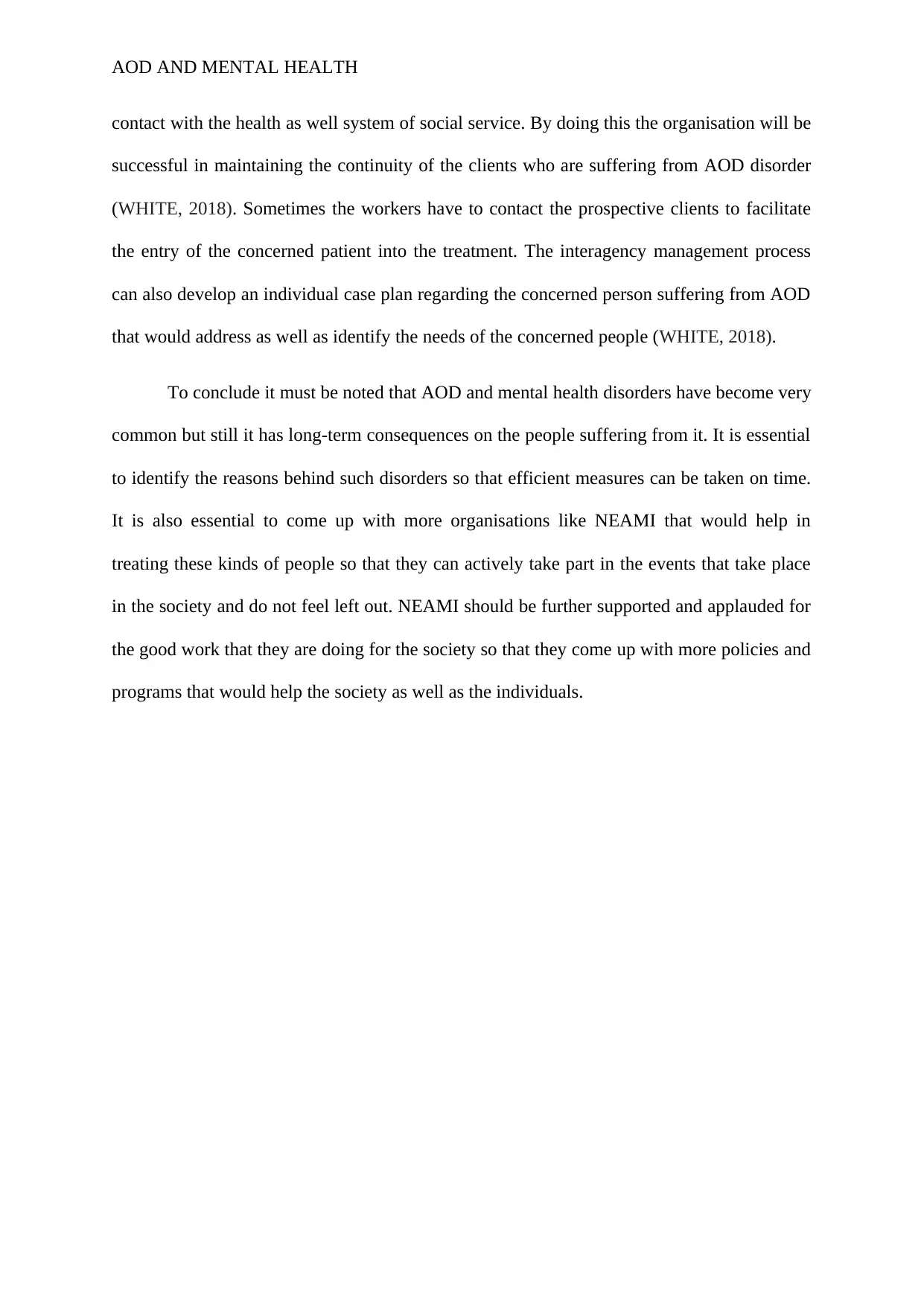
AOD AND MENTAL HEALTH
contact with the health as well system of social service. By doing this the organisation will be
successful in maintaining the continuity of the clients who are suffering from AOD disorder
(WHITE, 2018). Sometimes the workers have to contact the prospective clients to facilitate
the entry of the concerned patient into the treatment. The interagency management process
can also develop an individual case plan regarding the concerned person suffering from AOD
that would address as well as identify the needs of the concerned people (WHITE, 2018).
To conclude it must be noted that AOD and mental health disorders have become very
common but still it has long-term consequences on the people suffering from it. It is essential
to identify the reasons behind such disorders so that efficient measures can be taken on time.
It is also essential to come up with more organisations like NEAMI that would help in
treating these kinds of people so that they can actively take part in the events that take place
in the society and do not feel left out. NEAMI should be further supported and applauded for
the good work that they are doing for the society so that they come up with more policies and
programs that would help the society as well as the individuals.
contact with the health as well system of social service. By doing this the organisation will be
successful in maintaining the continuity of the clients who are suffering from AOD disorder
(WHITE, 2018). Sometimes the workers have to contact the prospective clients to facilitate
the entry of the concerned patient into the treatment. The interagency management process
can also develop an individual case plan regarding the concerned person suffering from AOD
that would address as well as identify the needs of the concerned people (WHITE, 2018).
To conclude it must be noted that AOD and mental health disorders have become very
common but still it has long-term consequences on the people suffering from it. It is essential
to identify the reasons behind such disorders so that efficient measures can be taken on time.
It is also essential to come up with more organisations like NEAMI that would help in
treating these kinds of people so that they can actively take part in the events that take place
in the society and do not feel left out. NEAMI should be further supported and applauded for
the good work that they are doing for the society so that they come up with more policies and
programs that would help the society as well as the individuals.
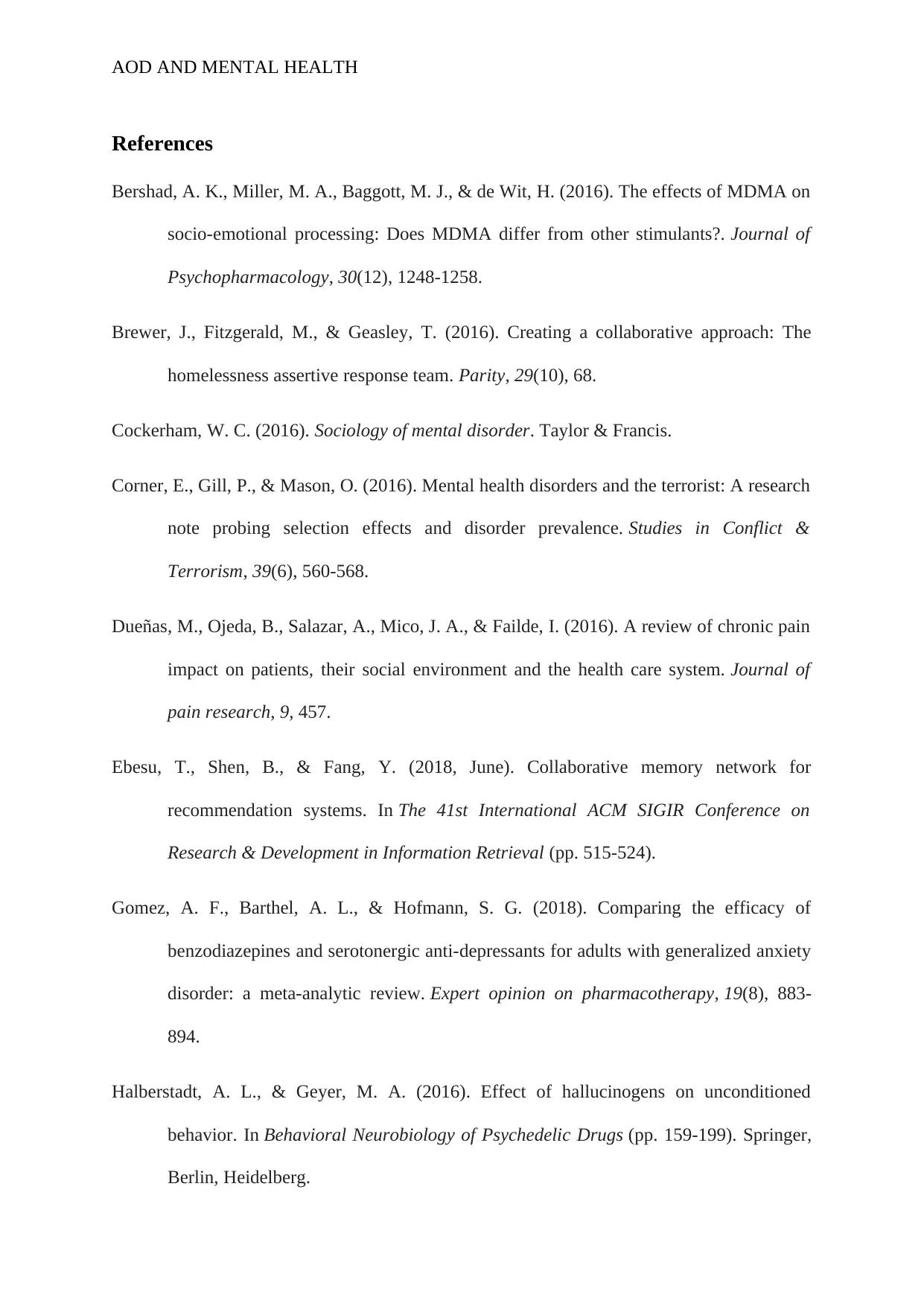
AOD AND MENTAL HEALTH
References
Bershad, A. K., Miller, M. A., Baggott, M. J., & de Wit, H. (2016). The effects of MDMA on
socio-emotional processing: Does MDMA differ from other stimulants?. Journal of
Psychopharmacology, 30(12), 1248-1258.
Brewer, J., Fitzgerald, M., & Geasley, T. (2016). Creating a collaborative approach: The
homelessness assertive response team. Parity, 29(10), 68.
Cockerham, W. C. (2016). Sociology of mental disorder. Taylor & Francis.
Corner, E., Gill, P., & Mason, O. (2016). Mental health disorders and the terrorist: A research
note probing selection effects and disorder prevalence. Studies in Conflict &
Terrorism, 39(6), 560-568.
Dueñas, M., Ojeda, B., Salazar, A., Mico, J. A., & Failde, I. (2016). A review of chronic pain
impact on patients, their social environment and the health care system. Journal of
pain research, 9, 457.
Ebesu, T., Shen, B., & Fang, Y. (2018, June). Collaborative memory network for
recommendation systems. In The 41st International ACM SIGIR Conference on
Research & Development in Information Retrieval (pp. 515-524).
Gomez, A. F., Barthel, A. L., & Hofmann, S. G. (2018). Comparing the efficacy of
benzodiazepines and serotonergic anti-depressants for adults with generalized anxiety
disorder: a meta-analytic review. Expert opinion on pharmacotherapy, 19(8), 883-
894.
Halberstadt, A. L., & Geyer, M. A. (2016). Effect of hallucinogens on unconditioned
behavior. In Behavioral Neurobiology of Psychedelic Drugs (pp. 159-199). Springer,
Berlin, Heidelberg.
References
Bershad, A. K., Miller, M. A., Baggott, M. J., & de Wit, H. (2016). The effects of MDMA on
socio-emotional processing: Does MDMA differ from other stimulants?. Journal of
Psychopharmacology, 30(12), 1248-1258.
Brewer, J., Fitzgerald, M., & Geasley, T. (2016). Creating a collaborative approach: The
homelessness assertive response team. Parity, 29(10), 68.
Cockerham, W. C. (2016). Sociology of mental disorder. Taylor & Francis.
Corner, E., Gill, P., & Mason, O. (2016). Mental health disorders and the terrorist: A research
note probing selection effects and disorder prevalence. Studies in Conflict &
Terrorism, 39(6), 560-568.
Dueñas, M., Ojeda, B., Salazar, A., Mico, J. A., & Failde, I. (2016). A review of chronic pain
impact on patients, their social environment and the health care system. Journal of
pain research, 9, 457.
Ebesu, T., Shen, B., & Fang, Y. (2018, June). Collaborative memory network for
recommendation systems. In The 41st International ACM SIGIR Conference on
Research & Development in Information Retrieval (pp. 515-524).
Gomez, A. F., Barthel, A. L., & Hofmann, S. G. (2018). Comparing the efficacy of
benzodiazepines and serotonergic anti-depressants for adults with generalized anxiety
disorder: a meta-analytic review. Expert opinion on pharmacotherapy, 19(8), 883-
894.
Halberstadt, A. L., & Geyer, M. A. (2016). Effect of hallucinogens on unconditioned
behavior. In Behavioral Neurobiology of Psychedelic Drugs (pp. 159-199). Springer,
Berlin, Heidelberg.
⊘ This is a preview!⊘
Do you want full access?
Subscribe today to unlock all pages.

Trusted by 1+ million students worldwide
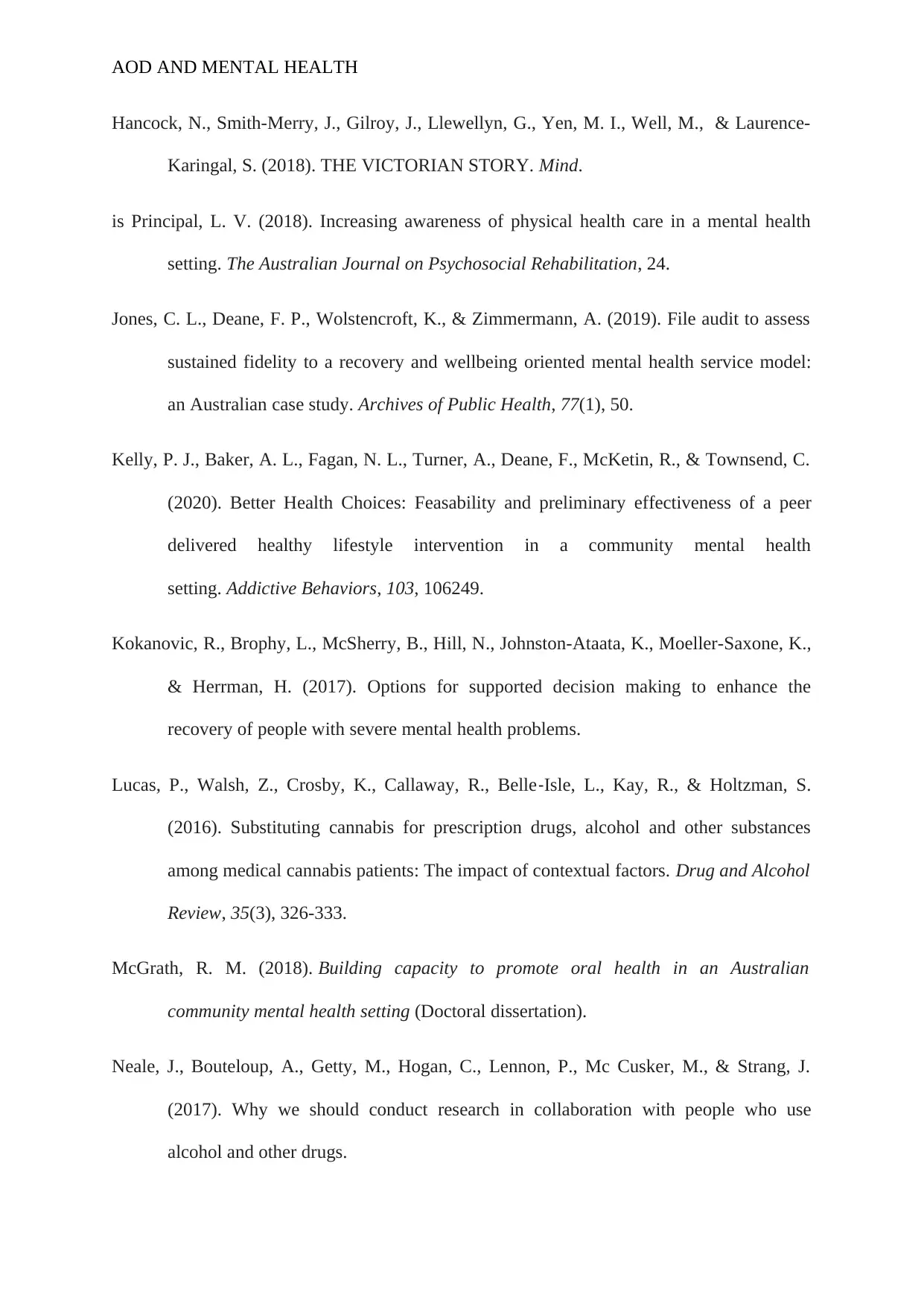
AOD AND MENTAL HEALTH
Hancock, N., Smith-Merry, J., Gilroy, J., Llewellyn, G., Yen, M. I., Well, M., & Laurence-
Karingal, S. (2018). THE VICTORIAN STORY. Mind.
is Principal, L. V. (2018). Increasing awareness of physical health care in a mental health
setting. The Australian Journal on Psychosocial Rehabilitation, 24.
Jones, C. L., Deane, F. P., Wolstencroft, K., & Zimmermann, A. (2019). File audit to assess
sustained fidelity to a recovery and wellbeing oriented mental health service model:
an Australian case study. Archives of Public Health, 77(1), 50.
Kelly, P. J., Baker, A. L., Fagan, N. L., Turner, A., Deane, F., McKetin, R., & Townsend, C.
(2020). Better Health Choices: Feasability and preliminary effectiveness of a peer
delivered healthy lifestyle intervention in a community mental health
setting. Addictive Behaviors, 103, 106249.
Kokanovic, R., Brophy, L., McSherry, B., Hill, N., Johnston-Ataata, K., Moeller-Saxone, K.,
& Herrman, H. (2017). Options for supported decision making to enhance the
recovery of people with severe mental health problems.
Lucas, P., Walsh, Z., Crosby, K., Callaway, R., Belle‐Isle, L., Kay, R., & Holtzman, S.
(2016). Substituting cannabis for prescription drugs, alcohol and other substances
among medical cannabis patients: The impact of contextual factors. Drug and Alcohol
Review, 35(3), 326-333.
McGrath, R. M. (2018). Building capacity to promote oral health in an Australian
community mental health setting (Doctoral dissertation).
Neale, J., Bouteloup, A., Getty, M., Hogan, C., Lennon, P., Mc Cusker, M., & Strang, J.
(2017). Why we should conduct research in collaboration with people who use
alcohol and other drugs.
Hancock, N., Smith-Merry, J., Gilroy, J., Llewellyn, G., Yen, M. I., Well, M., & Laurence-
Karingal, S. (2018). THE VICTORIAN STORY. Mind.
is Principal, L. V. (2018). Increasing awareness of physical health care in a mental health
setting. The Australian Journal on Psychosocial Rehabilitation, 24.
Jones, C. L., Deane, F. P., Wolstencroft, K., & Zimmermann, A. (2019). File audit to assess
sustained fidelity to a recovery and wellbeing oriented mental health service model:
an Australian case study. Archives of Public Health, 77(1), 50.
Kelly, P. J., Baker, A. L., Fagan, N. L., Turner, A., Deane, F., McKetin, R., & Townsend, C.
(2020). Better Health Choices: Feasability and preliminary effectiveness of a peer
delivered healthy lifestyle intervention in a community mental health
setting. Addictive Behaviors, 103, 106249.
Kokanovic, R., Brophy, L., McSherry, B., Hill, N., Johnston-Ataata, K., Moeller-Saxone, K.,
& Herrman, H. (2017). Options for supported decision making to enhance the
recovery of people with severe mental health problems.
Lucas, P., Walsh, Z., Crosby, K., Callaway, R., Belle‐Isle, L., Kay, R., & Holtzman, S.
(2016). Substituting cannabis for prescription drugs, alcohol and other substances
among medical cannabis patients: The impact of contextual factors. Drug and Alcohol
Review, 35(3), 326-333.
McGrath, R. M. (2018). Building capacity to promote oral health in an Australian
community mental health setting (Doctoral dissertation).
Neale, J., Bouteloup, A., Getty, M., Hogan, C., Lennon, P., Mc Cusker, M., & Strang, J.
(2017). Why we should conduct research in collaboration with people who use
alcohol and other drugs.
Paraphrase This Document
Need a fresh take? Get an instant paraphrase of this document with our AI Paraphraser

AOD AND MENTAL HEALTH
Neppl, T. K., Senia, J. M., & Donnellan, M. B. (2016). Effects of economic hardship: Testing
the family stress model over time. Journal of family psychology, 30(1), 12.
Scanlan, J. N., Feder, K., Ennals, P., & Hancock, N. (2019). Outcomes of an individual
placement and support programme incorporating principles of the collaborative
recovery model. Australian occupational therapy journal, 66(4), 519-529.
Seeman, N., Tang, S., Brown, A. D., & Ing, A. (2016). World survey of mental illness
stigma. Journal of affective disorders, 190, 115-121.
Silove, D., Ventevogel, P., & Rees, S. (2017). The contemporary refugee crisis: an overview
of mental health challenges. World Psychiatry, 16(2), 130-139.
Spear, L. P. (2016). Consequences of adolescent use of alcohol and other drugs: studies using
rodent models. Neuroscience & Biobehavioral Reviews, 70, 228-243.
Tually, S., Baulderstone, J., Slatter, M., & Skinner, V. (2016). Beyond charity: the
engagement of the philanthropic and homelessness sectors in Australia: final report.
Waring, J., & Burns, A. (2016). Wadamba Wilam. Parity, 29(8), 43.
WHITE, C. Theme: Peer work and co-design. In 2019 Symposium Book of Proceedings (p.
62).
Wolstencroft, K. E., Deane, F. P., Jones, C. L., Zimmermann, A., & Cox, M. (2018).
Consumer and staff perspectives of the implementation frequency and value of
recovery and wellbeing oriented practices. International journal of mental health
systems, 12(1), 60.
Neppl, T. K., Senia, J. M., & Donnellan, M. B. (2016). Effects of economic hardship: Testing
the family stress model over time. Journal of family psychology, 30(1), 12.
Scanlan, J. N., Feder, K., Ennals, P., & Hancock, N. (2019). Outcomes of an individual
placement and support programme incorporating principles of the collaborative
recovery model. Australian occupational therapy journal, 66(4), 519-529.
Seeman, N., Tang, S., Brown, A. D., & Ing, A. (2016). World survey of mental illness
stigma. Journal of affective disorders, 190, 115-121.
Silove, D., Ventevogel, P., & Rees, S. (2017). The contemporary refugee crisis: an overview
of mental health challenges. World Psychiatry, 16(2), 130-139.
Spear, L. P. (2016). Consequences of adolescent use of alcohol and other drugs: studies using
rodent models. Neuroscience & Biobehavioral Reviews, 70, 228-243.
Tually, S., Baulderstone, J., Slatter, M., & Skinner, V. (2016). Beyond charity: the
engagement of the philanthropic and homelessness sectors in Australia: final report.
Waring, J., & Burns, A. (2016). Wadamba Wilam. Parity, 29(8), 43.
WHITE, C. Theme: Peer work and co-design. In 2019 Symposium Book of Proceedings (p.
62).
Wolstencroft, K. E., Deane, F. P., Jones, C. L., Zimmermann, A., & Cox, M. (2018).
Consumer and staff perspectives of the implementation frequency and value of
recovery and wellbeing oriented practices. International journal of mental health
systems, 12(1), 60.
1 out of 11
Related Documents
Your All-in-One AI-Powered Toolkit for Academic Success.
+13062052269
info@desklib.com
Available 24*7 on WhatsApp / Email
![[object Object]](/_next/static/media/star-bottom.7253800d.svg)
Unlock your academic potential
Copyright © 2020–2025 A2Z Services. All Rights Reserved. Developed and managed by ZUCOL.





